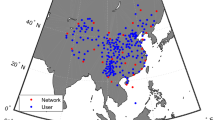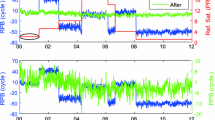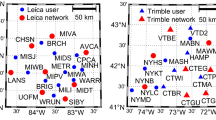Abstract
Typically, navigation software processes global navigation satellite system (GNSS) phase observables along with the code observables to achieve high-precision positioning. However, the unmodeled code-related errors, typically multipath effects, may deteriorate the positioning performance. Such effects are well known for the second generation BeiDou navigation satellite system (BDS-2). To prevent this adverse effect on the state-of-the-art positioning technique, namely integer ambiguity resolution-enabled precise point positioning (PPP-RTK), we propose a multi-frequency phase-only PPP-RTK model. This model excludes the code observables and addresses the rank deficiency problem underlying the phase observation equations at the undifferenced and uncombined level. To verify the model, we collect five-day triple-frequency BDS 30-s data from a network of seven reference stations (about 112 km apart) to estimate the products on the network side. Based on these products, we conduct simulated dynamic positioning at a user station to test the phase-only PPP-RTK model and compare it with the customary code-plus-phase (CPP) model. The results show that the satellite phase biases, existing only at the third frequency, have a precision of better than two centimeters, while the precision of the satellite clock and ionospheric delay is better than eight centimeters. Due to the strong correlation between individual corrections, it is necessary to assess the quality of combined products, including the satellite clock, satellite phase bias and ionospheric delay, the precision of which is several millimeters to two centimeters, which is sufficiently precise for user positioning. Regarding BDS-2 positioning, the time-to-first-fix (TTFF) of the CPP PPP-RTK is 12 epochs, while it is only three epochs for the phase-only PPP-RTK. The reason why the CPP model underperforms the phase-only model is that the BDS-2 data collected are subject to notable code multipath. We show that the code multipath in the third-generation BDS (BDS-3) data is mild, so the CPP PPP-RTK achieves instantaneous centimeter-level positioning with a TTFF of one epoch. The BDS-3 phase-only PPP-RTK obtains virtually the same positioning results, but the TTFF is two epochs. When combining BDS-2 with BDS-3, the TTFF of both models remains unchanged compared to that of the BDS-3 solutions, implying that ambiguity resolution based on the stronger dual-system CPP model is robust to the BDS-2 code multipath. However, the ambiguity-float solution of the CPP PPP-RTK is adversely affected by the code multipath and requires 43 epochs to convergence, while its phase-only counterpart needs 36 epochs.















Similar content being viewed by others
Data availability
The datasets that support the findings of this research are available from the corresponding author on reasonable request.
Abbreviations
- BDS:
-
BeiDou navigation satellite system
- CDMA:
-
Code division multiple access
- CLK:
-
Clock
- CPP:
-
Code-plus-phase
- DOY:
-
Day of year
- FDMA:
-
Frequency division multiple access
- GEO:
-
Geostationary orbit
- GNSS:
-
Global navigation satellite system
- GPS:
-
Global positioning system
- IGSO:
-
Inclined geosynchronous orbit
- ION:
-
Ionosphere
- MEO:
-
Medium orbit
- PPP-RTK:
-
Integer ambiguity resolution-enabled precise point positioning
- RMS:
-
Root-mean-square
- RTK:
-
Real-time kinematic
- SPB:
-
Satellite phase bias
- STD:
-
Standard deviation
- TTFF:
-
Time-to-first-fix
References
Amiri-Simkooei A (2013) Application of least squares variance component estimation to errors-in-variables models. J Geodesy 87(10):935–944
Baarda W (1973) S-transformations and criterion matrices. In: Publications on Geodesy, 18 (vol 5, no 1), Netherlands Geodetic Commission, Delft, The Netherlands
Banville S et al. (2021) Enabling ambiguity resolution in CSRS-PPP. Navigation 68(2):433–451
Blewitt G (1990) An automatic editing algorithm for GPS data. Geophys Res Lett 17(3):199–202
Byun SH, Hajj GA, Young LE (2002) Development and application of GPS signal multipath simulator. Radio Sci 37(6):1–23
Chang X-W, Guo Y (2005) Huber’s M-estimation in relative GPS positioning: computational aspects. J Geodesy 79(6):351–362
Chu F-Y, Yang M, Wu J (2016) A new approach to modernized GPS phase-only ambiguity resolution over long baselines. J Geodesy 90(3):241–254
Collins P, Bisnath S, Lahaye F, Héroux P (2010) Undifferenced GPS ambiguity resolution using the decoupled clock model and ambiguity datum fixing. Navigation 57(2):123–135
Estey LH, Meertens CM (1999) TEQC: the multi-purpose toolkit for GPS/GLONASS data. GPS Solutions 3(1):42–49
Eueler HJ, Goad CC (1991) On optimal filtering of GPS dual frequency observations without using orbit information. Bulletin Géodésique 65(2):130–143
Ge M, Gendt G, Ma R, Shi C, Liu J (2008) Resolution of GPS carrier-phase ambiguities in precise point positioning (PPP) with daily observations. J Geodesy 82(7):389–399
Hassibi A, Boyd S (1998) Integer parameter estimation in linear models with applications to GPS. IEEE Trans Signal Proc 46(11):2938–2952
Hauschild A, Montenbruck O, Sleewaegen J-M, Huisman L, Teunissen PJ (2012) Characterization of compass M-1 signals. GPS Solutions 16(1):117–126
Hou P, Zhang B, Yuan Y (2021) Combined GPS+ BDS instantaneous single- and dual-frequency RTK positioning: stochastic modelling and performance assessment. J Spat Sci 66(1):3–26
Khodabandeh A, Teunissen P (2015) An analytical study of PPP-RTK corrections: precision, correlation and user-impact. J Geodesy 89(11):1109–1132
Khodabandeh A, Amiri-Simkooei A, Sharifi M (2012) GPS position time-series analysis based on asymptotic normality of M-estimation. J Geodesy 86(1):15–33
Khodabandeh A, Zaminpardaz S, Nadarajah N (2021) A study on multi-GNSS phase-only positioning. Meas Sci Technol 32(9):095005
Laurichesse D, Mercier F, Berthias JP, Broca P, Cerri L (2009) Integer ambiguity resolution on undifferenced GPS phase measurements and its application to PPP and satellite precise orbit determination. Navigation 56(2):135–149
Leick A, Rapoport L, Tatarnikov D (2015) GPS Satellite Surveying. Wiley, Hoboken
Lu R, Chen W, Dong D, Wang Z, Zhang C, Peng Y, Yu C (2021) Multipath mitigation in GNSS precise point positioning based on trend-surface analysis and multipath hemispherical map. GPS Solutions 25(3):1–14
Montenbruck O, Hauschild A, Steigenberger P, Hugentobler U, Teunissen P, Nakamura S (2013) Initial assessment of the COMPASS/BeiDou-2 regional navigation satellite system. GPS Solutions 17(2):211–222
Odijk D (2002) Fast precise GPS positioning in the presence of ionospheric delays. In: Publications on Geodesy, 52, Netherlands Geodetic Commission, Delft, The Netherlands
Pan L, Guo F, Ma F (2018) An improved BDS satellite-induced code bias correction model considering the consistency of multipath combinations. Remote Sensing 10(8):1189
Remondi BW, Brown G (2000) Triple differencing with Kalman filtering: making it work. GPS Solutions 3(3):58–64
Strode PR, Groves PD (2016) GNSS multipath detection using three-frequency signal-to-noise measurements. GPS Solutions 20(3):399–412
Teunissen PJG (1985) Generalized inverses, adjustment the datum problem and S-transformations. In: Grafarend EW, Sanso F (eds) Optimization and design of geodetic networks. Springer, Berlin
Teunissen PJG (1995) The least-squares ambiguity decorrelation adjustment: a method for fast GPS integer ambiguity estimation. J Geodesy 70(1–2):65–82
Teunissen P (2001) Integer estimation in the presence of biases. J Geodesy 75(7):399–407
Teunissen PJG (2019) A new GLONASS FDMA model. GPS Solutions 23(4):1–19. https://doi.org/10.1007/s10291-019-0889-0
Teunissen PJG, Amiri-Simkooei AR (2008) Least-squares variance component estimation. J Geodesy 82(2):65–82
Teunissen PJG, Khodabandeh A (2015) Review and principles of PPP-RTK methods. J Geodesy 89(3):217–240
Teunissen PJG, Kleusberg A (2012) GPS for Geodesy. Springer, Berlin
Teunissen PJG, Montenbruck O (2017) Springer Handbook of Global Navigation Satellite Systems. Springer, Berlin
Teunissen P, Odijk D (2003) Rank-defect integer estimation and phase-only modernized GPS ambiguity resolution. J Geodesy 76(9):523–535
Teunissen P, De Jonge P, Tiberius C (1997) The least-squares ambiguity decorrelation adjustment: its performance on short GPS baselines and short observation spans. J Geodesy 71(10):589–602
Teunissen PJG, Odijk D, Zhang B (2010) PPP-RTK: results of CORS network-based PPP with integer ambiguity resolution. J Aeronaut Astronaut Aviat Ser A 42(4):223–230
Wang K, Chen P, Teunissen PJ (2018) Fast phase-only positioning with triple-frequency GPS. Sensors 18(11):3922
Wanninger L, Beer S (2015) BeiDou satellite-induced code pseudorange variations: diagnosis and therapy. GPS Solutions 19(4):639–648
Wübbena G, Schmitz M, Bagge A (2005) PPP-RTK: precise point positioning using state-space representation in RTK networks. In: Proc. ION GNSS 2005, The Institute of Navigation, 2005. Long Beach, CA, September 13–16, pp 13–16
Yang Y, Gao W (2006) An optimal adaptive Kalman filter. J Geodesy 80(4):177–183
Yang Y, Li J, Xu J, Tang J, Guo H, He H (2011) Contribution of the compass satellite navigation system to global PNT users. Chin Sci Bull 56(26):2813–2819
Zha J, Zhang B, Liu T, Hou P (2021) Ionosphere-weighted undifferenced and uncombined PPP-RTK: theoretical models and experimental results. GPS Solutions 25(4):1–12
Zhang X, He X, Liu W (2017a) Characteristics of systematic errors in the BDS Hatch–Melbourne–Wübbena combination and its influence on wide-lane ambiguity resolution. GPS Solutions 21(1):265–277
Zhang X, Wu M, Liu W, Li X, Yu S, Lu C, Wickert J (2017b) Initial assessment of the COMPASS/BeiDou-3: New-generation navigation signals. J Geodesy 91(10):1225–1240
Zhang B, Hou P, Zha J, Liu T (2021) Integer-estimable FDMA model as an enabler of GLONASS PPP-RTK. J Geodesy 95(8):1–21. https://doi.org/10.1007/s00190-021-01546-0
Acknowledgements
This work was partially funded by the National Natural Science Foundation of China (Grant Nos. 42022025, 41774042), the Key Research and Development Plan of Hubei Province (Grant No. 2020BHB014), and the Scientific Instrument Developing Project of the Chinese Academy of Sciences (Grant No. YJKYYQ20190063). The CAS Pioneer Hundred Talents Program supports the second author.
Author information
Authors and Affiliations
Corresponding author
Additional information
Publisher's Note
Springer Nature remains neutral with regard to jurisdictional claims in published maps and institutional affiliations.
Rights and permissions
About this article
Cite this article
Hou, P., Zhang, B., Yasyukevich, Y.V. et al. Multi-frequency phase-only PPP-RTK model applied to BeiDou data. GPS Solut 26, 76 (2022). https://doi.org/10.1007/s10291-022-01263-x
Received:
Accepted:
Published:
DOI: https://doi.org/10.1007/s10291-022-01263-x




